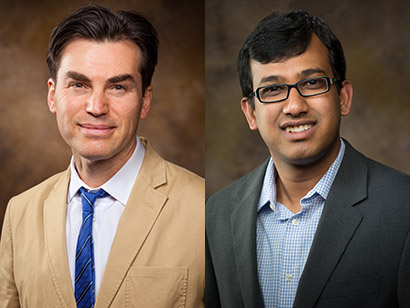Physicists Create Artificial 'Graphene'
FAYETTEVILLE, Ark. – An international group of physicists led by the University of Arkansas has created an artificial material with a structure comparable to graphene.
“We’ve basically created the first artificial graphene-like structure with transition metal atoms in place of carbon atoms,” said Jak Chakhalian, professor of physics and director of the Artificial Quantum Materials Laboratory at the U of A.
In 2014, Chakhalian was selected as a quantum materials investigator for the Gordon and Betty Moore Foundation. His selection came with a $1.8 million grant, a portion of which funded the study.
Graphene, discovered in 2004, is a one-atom-thick sheet of graphite. Graphene transistors are predicted to be substantially faster and more heat tolerant than today’s silicon transistors and may result in more efficient computers and the next-generation of flexible electronics. Its discoverers were awarded the Nobel Prize in physics in 2010.
The U of A-led group published its findings this week in Physical Review Letters, the journal of the American Physical Society, in a paper titled “Mott Electrons in an Artificial Graphene-like Crystal of Rare Earth Nickelate.”
“This discovery gives us the ability to create graphene-like structures for many other elements,” said Srimanta Middey, a postdoctoral research associate at the U of A who led the study.
The research group also included U of A postdoctoral research associates Michael Kareev and Yanwei Cao, doctoral student Xiaoran Liu and recent doctoral graduate Derek Meyers, now at Brookhaven National Laboratory.
Additional members of the group were David Doennig of the University of Munich, Rossitza Pentcheva of the University of Duisburg-Essen in Germany, Zhenzhong Yang, Jinan Shi and Lin Gu of the Chinese Academy of Sciences; and John W. Freeland and Phillip Ryan of the Advanced Photon Source at Argonne National Laboratory near Chicago.
The research was also partially funded by the Chinese Academy of Sciences.
About the University of Arkansas: The University of Arkansas provides an internationally competitive education for undergraduate and graduate students in more than 200 academic programs. The university contributes new knowledge, economic development, basic and applied research, and creative activity while also providing service to academic and professional disciplines. The Carnegie Foundation classifies the University of Arkansas among only 2 percent of universities in America that have the highest level of research activity. U.S. News & World Report ranks the University of Arkansas among its top American public research universities. Founded in 1871, the University of Arkansas comprises 10 colleges and schools and maintains a low student-to-faculty ratio that promotes personal attention and close mentoring.
Contacts
Jak Chakhalian, professor, Department of Physics
J. William Fulbright College of Arts and Sciences
479-575-4313, jchakhal@uark.edu
Chris Branam, research communications writer/editor
University Relations
479-575-4737, cwbranam@uark.edu
